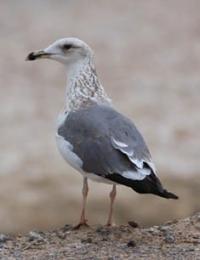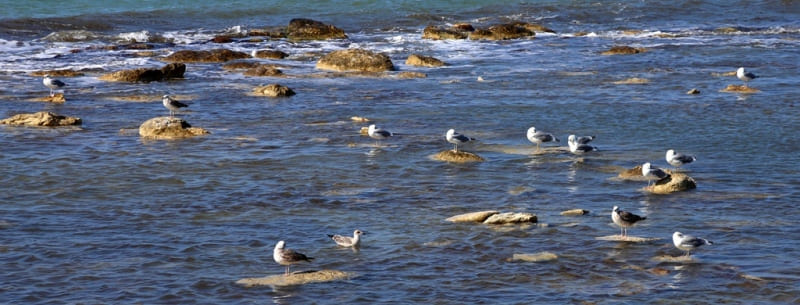You are here
Fauna of Khazar Reserve.

Photo tours to Khazar Reserve.
“Fish, you are both a boat and a rower,
The blue abyss is your palace.
Is there an island in the world where the fugitive
Could you not be afraid of eternal disasters?
"Swans". Translation by A. Tarkovsky. Makhtumkuli.
Ornithological tours to Khazar Reserve.
According to the zoogeographic zoning scheme, the territory of the reserve belongs to Irano-Turan region or to the Aral-Caspian deserts. The structure of ecosystems that has formed in the reserve meets the conditions in which it is possible to preserve mass wintering of birds.
About 80% of the area is occupied by the waters of sea bays, where the shallow waters of the southeast of the Caspian Sea are represented with an abundance of phyto- and zoobenthos, a high concentration of fish, and in the cold season - waterfowl and semiaquatic birds.
About 10% of the area is occupied by shallow coastal ecosystems. In the structure of the ecosystems of the reserve, the share of freshwater ecosystems is also significant (Delili lakes, Atrek rivers, etc.). The fauna of the reserve is dominated by birds (more than 260 species), many fish (48), amphibians (2), reptiles (37) and mammals (47), the largest of which is the Caspian seal, which is endemic to the Caspian Sea.
Insects and other important invertebrates. Applied to the Khazar Reserve it is necessary to separate aquatic and terrestrial invertebrates. Of the terrestrial invertebrates, two species are listed in the Red Data Book of Turkmenistan (1999): Fatima's mix - Epallage fattime (Charpentier, 1840); short-winged bolivaria - Bolivaria brachyptera (Pallas, 1773).
The state of the terrestrial entomofauna of the Khazar Reserve is poorly studied and requires additional research.
Zooplankton of Khazar Reserve. Aquatic marine organisms are traditionally characterized in terms of their "resource" role. The zooplankton of the Caspian Sea is relatively poor in terms of species (about 120 species).
These are copepods and cladocerans, rotifers and ciliates. The main part of them are autochthonous (i.e. local) species with a large number of endemics of Caspian origin. They are most fully represented in the zone of the highest and most stable salinity (12 - 13‰), i.e. in the South Caspian, in particular near its eastern shores.
Representatives of the Arctic fauna: Copepoda Limnokalanus and 4 more species of planktonic crustaceans (genus Mysida) live in the deep waters of this area. Mediterranean species are characterized by euryhalinity, significant concentrations of which are formed mainly in the coastal, most saline, but well aerated zone.
The fourth ecological group - freshwater species, are represented mainly by small cladocerans and microscopic bryozoans. The gross biomass of zooplankton in the South Caspian ranges from 0.9 to 2.5,000,000 tons.
The most characteristic zooplankton species of the South-Eastern Caspian are the crustacean Erythemora minor (which is an indicator species of this part of the sea) and Rhizosolinia, distinguished by two mass breeding outbreaks - in May and in autumn - in October.
These two species form the basis of nutrition of juveniles and adults of the most numerous and economically important species of the Caspian kilka genus, which themselves are a massive food item for valuable sturgeon in the South-East Caspian.
Zoobenthos of Khazar Reserve. The species living here (crustaceans, worms, mollusks and insects), along with asthenia-hydrophytes, form a food base for birds and representatives of the ichthyofauna; annual biomass production from 107.4 to 159.3 000 tons.
The most common of these are polychaete and oligochaete worms, the most numerous are mollusks (Mytilaster, Dreisena and Abra) and crustaceans (crab and sea acorn). Their number here reaches up to 1011 specimens per meter, biomass is about 45 g/m.
The biomass of benthos on the eastern shore of the Caspian Sea is the largest in compared to the entire Caspian. One of the main reasons for the lush development of life here is the hydrological regime. The rise of deep waters during vertical circulation brings here new and new masses of water saturated with biogenic substances.
The ichthyofauna of the reserve belongs to the Ponto-Caspian-Aral province of the Mediterranean subregions, is largely endemic and includes a number of rare and endangered species (sturgeon, Caspian salmon, etc.).
At the same time, the fish fauna of the Caspian Sea is significantly inferior to that of the open seas. In the South-Eastern Caspian, in particular, its wetlands from Esenguly to Bekdash, 50 species have been registered today, including sturgeon (5 species), sprat (3 species), herring (11 species and forms), salmon (2 species), pike (1 species), carp (8 species), mullet (3 species), perch (3 species), gobies (8 species), as well as 1 species of catfish, Caspian needle fish, Mississippi gambusia, southern stickleback.
One of the features of the biodiversity of the ichthyofauna is a large number of endemics. Endemism can be traced, starting with the category of the genus, increasing with the transition to smaller taxonomic categories: 8.2% of genera, 43.6% of species and 100% of subspecies are endemic to the Caspian.
In all protected bays of Khazar, there is a mass feeding of juveniles of commercial herring (Alosa brashnikovii) and mullet (sharp nose - Liza saliens, golden mullet - L. auratus). Valuable fish species are sprat (Clupeonella engrauliformis, С. delicatula, C. grimmi), carp (Cyprinus carpio; IUCN), roach (Rutilus rutilus), and others. Of the fish-like species, the Caspian lamprey (Caspiomyzon wagneri).
The Volga herring (Alosa kersleri volgensis) is ubiquitous, very rare salmon species are Caspian trout (Salmo trutta caspius), white fish (Stenodus lencichthys; IUCN), beluga (Huso huso; IUCN), (Acipenser nudiventris; IUCN), etc.
The group of sturgeons (Acipenser gueldenstaedtii, A. persicus, A. stellatus SOP) of the Caspian until recently represented 80% of the existing world stocks. The ichthyofauna of Maloe Delili, together with the Atrek channel, is represented by 17 species of fish, of which the barbel damask mai (Barbus capito capito, Kura barbel (B. lacerta cyri), Lankaran khramulya (Capoeta capoeta gracilis), Caucasian chub (Leuciscus cephalus orientalis), kutum (Rhodeus frisii kutum) and crested char (Nemacheilus malapterurus malapterurus) are absent in other places of inland waters.
Of the representatives of the ichthyofauna, 4 species are included in the Red Book of Turkmenistan (1999) and 6 - in the IUCN Red List (2000). Reptiles and amphibians. Amphibians include the green toad (Bufo viridis) and the lake frog (Rana ridibunda).
Of the reptiles in the Etrek lakes, there are marsh (Emys orbicularis; IUCN) and Caspian (Mauremys caspica) turtles. In total, 37 species are noted in the reserve. reptiles, of which the gray monitor lizard (Varanus griseus) and the Central Asian cobra (Naja oxiana) are listed in the Red Book of Turkmenistan (1999), the latter - in the IUCN Red List (2000).
Among the snakes, the most common species is the water snake (Natrix tessellata), and the rarest is the common snake (Natrix natrix), found only in the vicinity of Lake Delili. Of the poisonous, in addition to the Central Asian cobra, the sand efa (Echis multisquamatus) is also found in the coastal strip.
Birds of Khazar Reserve. The fauna of the reserve is dominated by birds among vertebrates. avifauna represent 20 orders, 51 families, 140 genera and 264 species, of which 55 are nesting species (S.A. Bukreev. “Ornitogeography and nature reserves of Turkmenistan”, 1997).
One of the most massive and ancient flyways of Palearctic birds to wintering grounds and back runs along the Caspian Sea. Favorable climatic, protective (from storms), food conditions and protected regime allow huge masses of birds to concentrate here (mainly waterfowl and near-water birds - 120 species from 13 orders).
Their total migration flow over the past 30 years has almost halved (a ubiquitous phenomenon in the Palearctic) and ranges from 5 to 8 million individuals, several hundred thousand of them settle here for 4-5 months of wintering.
In summer, closed habitats, overgrown with reeds, become nesting sites for the red-book mullet, some species of ducks, coots, moorhens, little bitterns, and on On numerous islands and spits, thousands of nesting colonies of gulls and terns are formed.
About 50 species of birds nest in the reserve (shelduck, marbled teal, gray duck, coot, bittern and little bittern, herons, francolin, Caspian plover, reed plover, shorebirds, etc.). More than 10 out of 117 passerine species nest in the reserve.
Of the 30 species of diurnal predators, 28 species occur on migration and wintering grounds, and only 2 species nest. Of these, 28 species are listed in the Red Book of Turkmenistan (1999), 14 - in the IUCN Red List (2000), 20 - in the CITES lists. Animals and plants of the Khazar State Reserve, included in Red Data Book of Turkmenistan (1999) and IUCN Red List (2000)/
Mammals of Khazar Reserve. The fauna of terrestrial and marine mammals is represented by 47 species (7 insectivores, 6 bats, 1 lagomorph, 17 rodents, 13 carnivores, 2 ungulates, 1 - pinnipeds). The most numerous are rodents, which is typical for desert and tugai landscapes.
complexes, from ungulates there are goitered gazelle and wild boar. Of the mammals of the reserve, 6 are included in the Red Book of Turkmenistan, 4 - in the IUCN Red List, 2 - in the CITES lists: honey badger (Mellivora capensis), otter (Lutra lutra), caracal (Felis caracal), goitered gazelle (Gazella subgutturosa), Indian porcupine ( Hystrix indica), striped hyena (Hyaena hyaena). Otter: IUCN category VU - occasionally found along the banks of the Atrek River.
Prefers sections of the river with a calm flow and overgrown banks animal, but moves quite far on land, overcoming obstacles, including islands. It feeds mainly on fish, as well as various aquatic and semi-aquatic invertebrates.
Goitered gazelle: IUCN category LR - isolated occurrences in inter-dune depressions of the Darja Peninsula. It is finally driven out of here by the massive grazing of small cattle and hunting. There are quite a lot of goitered gazelle on Ogurchinsky Island, which was the result of work to create a reserve population in the early 1980s.
Currently, reintroduction of animals to the Western Kopetdag is carried out from here. Aquatic mammals are represented by one species of pinnipeds, endemic to the Caspian Sea Caspian seal (Phoca caspica Gmelin). In the South-Eastern Caspian, it is widely distributed from Esenguly to Bekdash.
The main places of its concentration in different seasons of the year are the areas of the islands of Ogurchinsky, Osushnaya, as well as the North Cheleken and Krasnovodskaya spits of the Turkmenbashi Bay. Back in the 80s of the XX century, its population in the South Caspian was no more than 50 thousand individuals.
The age ratio of seals in places of concentration (rookeries) within Turkmenistan makes the following picture: young animals (2 - 6 years old) - about 50%, one-year-olds - 20%, large mature individuals - 30%. One of the main periodic phenomena in the biology of the Caspian seal is their seasonal migration to the North Caspian and back.
Already in September in the area of Karshi, Aim, Kara-Bogaz-Gol single and groups of these animals are systematically observed. In some cases, they were noted on the dry edge of the sandy flagstone of small islands at a distance of 1.0 - 3.5 kilometers from the coast and coastal rocks.
Solitary animals systematically swim in the coastal northern and northeastern parts of the Turkmenbashi Bay, as well as the North Cheleken Bay. For the winter in the above places, the main concentration of seals annually remains up to 7 - 11,000
individuals, a few cases of pups were noted, as well as the presence of “seals” among the island concentrations of adult seals. This phenomenon is extremely important in the conservation of the entire population of the Caspian seal.
Geographical coordinates of Khazar Reserve: N37°39'57.59" E53°52'40.54"


Authority:
"Reserves of Central Asia and Kazakhstan". Under the general editorship of R.V. Yashchenko. Tethys edition. Editorial Board of the Scientific Society "Tethys": R.Ya. Yashchenko chairman), O.V. Belyalov, V.P. Krivenko, O.E. Lopatin, I.V. Mitrofanov, K.M. Pachikin. Marmazinskaya N. July 25, 2006. Berkeliev T. http://iucnca.net
Photos by
Alexander Petrov.







